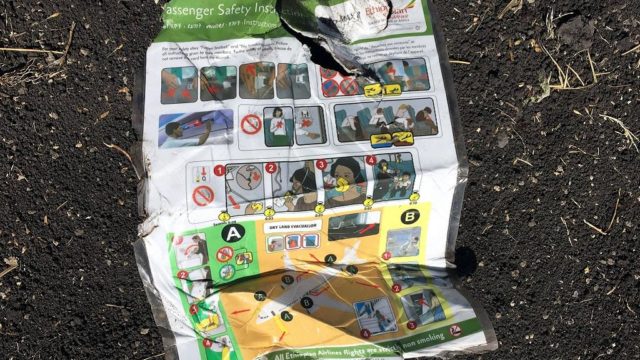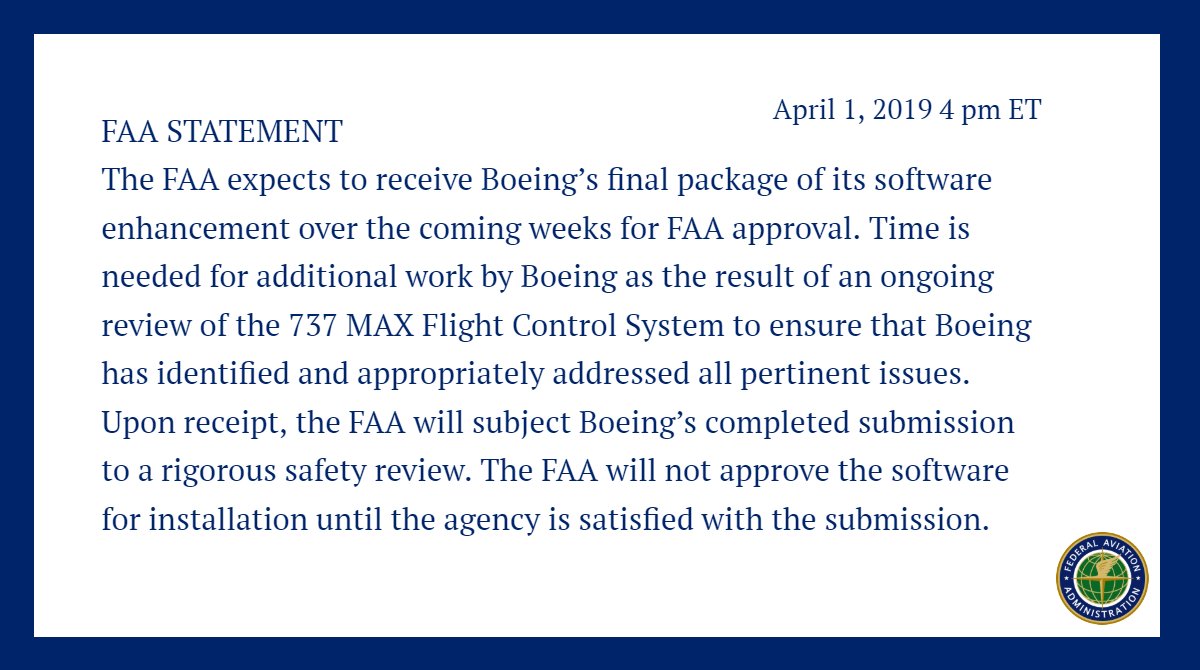AFP || On March 10, the world was hit by the news that a passenger aircraft operated by Africa’s top national carrier had crashed. The reference point for the information was solely the office of Ethiopian Prime Minister Abiy Ahmed.
This article focuses on a rolling coverage of the incident straddling the before, during and aftermath of what is one of the deadliest incidents Ethiopian has faced in recent years.
you can read about the following areas in our continued coverage below:
- What has Boeing done to fix MCAS?
- A month after crash, 10 key incidents
- DNA samples to be tested in UK
- Ethiopian reconsidering Boeing 737 MAX orders
- Indonesia, Singapore join ET302 probe
- Pilots followed Boeing’s instructions but lost control
- Report no-show, FAA warns Boeing
- Preliminary report out today (April 1)
- Last words of one of the pilots before crash
- Anti-stall feature active at time of crash
- Boeing sued in Chicago court by Rwandan kids
US regulator meets commercial airlines
The US Federal Aviation Administration (FAA) will on Friday meet with American commercial airlines that use the Boeing 737 MAX, which has been grounded worldwide since mid-March following two accidents that killed 346 people.
“The purpose of this meeting is for the FAA to gather facts, information, and individual views to further understand their views as FAA decides what needs to be done before returning the aircraft to service,” the agency said in a statement.
Security representatives from American Airlines, Southwest and United will be at the meeting, as well as representatives from their pilot unions.
American and Southwest use the 737 MAX 8, while United has 737 MAX 9 aircraft in its fleet.
The FAA recently formed an action committee with NASA and international civil aviation authorities to help certify the fix to the MCAS anti-stall system Boeing developed specifically for the 737 MAX.
The MCAS is believed to have been a key factor in both the Ethiopian Airlines crash and the Lion Air crash in Indonesia that killed 189 people in October.
What has Boeing done to fix MCAS?
Boeing CEO Dennis Muilenberg said Thursday that the changes the aircraft manufacturer is working on will make the 737 MAX “even safer by preventing erroneous angle of attack sensor readings” from triggering the MCAS.
Speaking in public for the first time since the Ethiopian Airlines crash, Muilenberg told a conference in Dallas, Texas that Boeing has conducted 96 test flights of the modified 737 MAXand the pilots have taken part in more than 159 hours of tests.
He added that he had been on board one test flight in Seattle and that the software update “functioned as designed.”
“In these challenging times, I am even more confident we will come through this even stronger,” he said in conclusion, adding he “(regrets) the impact the grounding has had on all of our airline customers and their passengers.”
Muilenberg is expected to answer questions from the financial community on April 24 as part of the release of Boeing’s first quarter results.
10 key incidents since ET302 crash
April 10, 2019 marks exactly a month since the Ethiopian Airlines Boeing 737 Max crashed in the town of Bishoftu in Ethiopia’s Oromia region.
The flight was on its way to the Kenyan capital Nairobi but it made only six minutes out of the over two hours flight before crashing and killing all persons on board.
This article looks back at 10 critical moments after the crash as part of our rolling coverage of the incident which was keenly followed by our audience in March.
1 – All 157 aboard killed
2 – Boeing 737 MAX 8s grounded worldwide
3 – Black boxes flown to Paris
4 – First burial ceremony held in Addis Ababa
5 – PM speaks with Trump over incident
6 – Airline, customers fights foreign media misreport on crash
7 – Ethiopian wins award in Kigali
8 – Preliminary report released
9 – Boeing admits errors vows robust response
10 – DNA samples of victims to be flown to UK for tests
DNA test of victims to be undertaken in London
In the wake of the accident, Ethiopian authorities reported that all victims had been burnt beyond recognition. Subsequently, grieving families were given earth for burial ceremonies that took place last month.
The Bloomberg news portal is reporting that Ethiopia will send DNA samples from the Boeing 737 MAX 8 crash for identification tests in London.
The accident killed all 157 people on board – 149 passengers and eight crew members. Authorities will transport human tissues gathered by a team led by Interpol and the U.K.’s Blake Emergency Services.
Paris became a center of attraction after the crash when Ethiopia opted to send black boxes – flight recorders – for information on them to be downloaded.
Germany was first mentioned as destination for the exercise but they turned down the request due to the complicated nature of the test. The information was downloaded by the multi-pronged team.
It was the basis on which Ethiopian government released a preliminary crash report last week. Boeing via its CEO has admitted errors in a key software and pledged robust responses. The plane maker has suffered huge losses in aftermath of the incident.
Ethiopian considers Boeing purchase orders
The Bloomberg news portal is reporting that Ethiopian Airlines is reconsidering its orders for Boeing 737 MAX jets following the release of a preliminary report into the ET302 crash.
“We may reach the decision: Look, we just had a very tragic accident a few weeks ago, and customers still have the accident in their mind. So it will be a hard sell for us to convince our customers,” Tewolde GebreMariam is quoted to have said.
Ethiopian had earlier ordered 30 of the now controversial jets with five delivered at the time of the crash. The airline will not take delivery of the remaining 25 anytime soon – or perhaps at all, Tewolde said.
According to him, the decision on the 737 Max purchases will come after Boeing offers a software fix to a system implicated in the crash – and an earlier Lion Air crash. They will also base their decision based on what regulators and other airlines do.
“Our situation is quite different from the others, because we are the victim. You can imagine the stigma that will be attached with the airplane,’’ Tewolde added.
Ethiopian, Africa’s biggest flier, will need to do a lot of work by way of trying to convince its staff and customers before they resume use of the jet which has been grounded worldwide in the wake of the March 10 crash.
Indonesia, Singapore join investigations
Indonesia will send two investigators to Ethiopia to assist in a probe and exchange data on two fatal crashes of Boeing 737 MAX jets since October, the head of the country’s air safety agency told Reuters on Friday.
Indonesian investigators will travel to the Ethiopian capital Addis Ababa on April 15, said Soerjanto Tjahjono, head of the National Transportation Safety Committee (KNKT).
“They will help in assisting Ethiopia. We will study the data to assess whether there are similarities or whether there is any new information from the accident,” Tjahjono said by telephone.
A preliminary report on the Ethiopian Airlines’ crash showed on Thursday that the doomed jet travelled at an excessive speed and was forced downwards by a wrongly-triggered automation system as pilots wrestled to regain control.
Tjahjono said it was too early to draw any conclusions from the Ethiopian report or determine any links between the crashes because it contained factual data without analysis.
“We have already observed some similarities…but we cannot determine them exactly until after our investigators go to Ethiopia when we will conduct a joint investigation,” he said.
The two Indonesian investigators would sign an agreement on their role under an International Civil Aviation Organisation (ICAO) protocol, he said.
A preliminary report into the crash of the Lion Air 737 MAX in Indonesia suggested pilots lost control after grappling with the MCAS software, a new automated anti-stall feature that repeatedly lowered the nose based on a faulty sensor data.
Securing safety of MAX planes
Meanwhile, the Civil Aviation Authority of Singapore on Friday said that it would participate in a technical review panel on the Boeing Co 737 MAX jet led by the U.S. Federal Aviation Administration (FAA).
The FAA said on Wednesday that it is forming an international team to review the safety of the Boeing 737 MAX, which was grounded after two fatal crashes since October.
Boeing boss speaks on accidents
Following the release of a preliminary report on the ET302 crash, Boeing issued its response on Thursday in a statement that admitted technical errors whiles promising a robust series of steps going forward.
The statement posted on its website was signed by its Chairman, president and CEO , Dennis Muilenburg.
“The full details of what happened in the two accidents will be issued by the government authorities in the final reports, but, with the release of the preliminary report of the Ethiopian Airlines Flight 302 accident investigation, it’s apparent that in both flights the Maneuvering Characteristics Augmentation System, known as MCAS, activated in response to erroneous angle of attack information.
“The history of our industry shows most accidents are caused by a chain of events. This again is the case here, and we know we can break one of those chain links in these two accidents.
“As pilots have told us, erroneous activation of the MCAS function can add to what is already a high workload environment. It’s our responsibility to eliminate this risk. We own it and we know how to do it,” he said in part.
Details from preliminary report
Four main findings:
1. Aircraft passed airworthiness test before takeoff.
2. Crew properly licensed to operate the flight
3. Takeoff was normal
4. Boeing procedures were used but the crew was unable to control the flight
Twin safety recommendation to Boeing:
1. A review of flight control system
2. Review should be adequately vetted before planes allowed back in the skies.
Main information sources for current report:
Black box data
a. Flight Data Recorder (FDR) and
b. Cockpit Voice Recorder (CVR)
Info gathered from crash site, civial aviation authorities, the airline etc.
Parties involved in the probe:
a. Ethiopia Civil Aviation Authority – lead
b. US National Transport Safety Board
c. US Federal Aviation Authority
d. European air safety body
e. French aviation investigators
f. Boeing etc.
Other details:
Technocrat who led the probe says no missing/damaged sensor as reported
The continuing probe could last a year or even more
Minister says the overarching aim of the probe is to guarantee air travel safety
Confirms Attorney General in charge of legal issues
Preliminary report expected today, April 4
Investigators will release on Thursday a keenly awaited report on the deadly crash of an Ethiopian Airlines jet, Ethiopia’s Transport Ministry said, giving the first official clues to the second crash of a new Boeing 737 MAX in five months.
“The 10:30 a.m. (0730 GMT) press conference is to present the preliminary report,” Ethiopian Transport Ministry spokesman Musie Yehyies said.
The report may shed light on how a piece of cockpit software came back to life after pilots initially switched it off as they tried to save the doomed jet, people familiar with the matter said, placing both technology and crew in the spotlight.
Some 35 nationalities were among the 157 passengers and crew who died when the nearly full plane crashed six minutes after take-off from Addis Ababa, the Ethiopian capital, in clear conditions.
The March 10 disaster prompted a worldwide grounding of Boeing’s best-selling plane and scrutiny of its certification process.
Pilots followed Boeing’s instructions to the latter
The Wall Street Journal has reported what it says are crucial information from the flight recorder – black box – analysis of the ill-fated Ethiopian ET302 crash.
The latest details said pilots in charge of the Boeing Co. 737 MAX initially followed emergency procedures laid out by the plane maker but still failed to recover control of the jet.
Sources close to the probe said after turning off a flight-control system that was automatically pushing down the plane’s nose shortly after takeoff March 10, the crew couldn’t get the aircraft to maintain its balance till it crashed.
The disclosure of initial findings have been the subject of a ping-pong with Airline officials denying comments on it last week. Government officials also announced an imminent report release on Monday only to backtrack.
Preliminary report no-show, FAA to grill Boeing software
Authorities in Ethiopia flip-flopped on an earlier report on Monday that it was due to release a preliminary report on the ET302 crash. “Not today, maybe this week,” the source said, when asked about the report.
Incidentally this Reuters source was from the Transport Ministry which is leading the team probing the incident.
A Foreign Affairs Ministry official was cited for the initial information that the report was due to be released Monday. Nebiat Getachew was widely quoted with Bloomberg adding that embattled plane maker Boeing said it was reviewing the report.
Meanwhile the United States aviation regulator, the Federal Aviation Administration, FAA; says it was waiting to receive final package of Boeing’s software enhancement over the coming weeks.
FAA said in a statement: “Time is needed for Boeing to as the result of an ongoing review of the 737 MAX flight control system to ensure that Boeing has identified and appropriately addressed all pertinent issues.
Upon receipt, the FAA will subject Boeing’s completed submission to a rigorous safety review. The FAA not approve the software for installation until the agency is satisfied with the submission.”
The plane maker last week announced a software upgrade and invited its clients to a meeting over the issue. The meeting was however poorly attended with Ethiopian opting out.
Preliminary report expected today, April 1
Reports from Addis Ababa indicate that a preliminary report from the March 1 crash in Bishoftu is expected today, three weeks after the incident which claimed 157 people.
The Bloomberg news portal quoted a Foreign Ministry official, Nebiat Getachew, as confirming the information. Embattled plane maker Boeing said it was reviewing the report.
The airline had last week disputed a news item that said its CEO had hinted that a report of the ET302 flight was due last week or earliest this week.
Ethiopian said at the time that in keeping with international standards, it was waiting for the result as all concerned parties and cautioned against irresponsible reportage.
“We, at Ethiopian strongly refutes recent reports which state that Ethiopian GCEO expected the preliminary release of a report into the March 10 crash of its Boeing 737-8 MAX “maybe this week or next week”.
Ethiopian GCEO did not say anything about the time the investigation report will be released,” the said in a statement.
Boeing has been under pressure as results are being awaited. Its 737 Max 8 jets have been grounded globally with its shares plumetting on the stock market.
Two key findings from the probe indicates that there were similarities between the March 10 crash and an October 2018 incident that involved Indonesian flier Lion Air.
Late last week, the Wall Street Journal, WSJ, reported that the plane’s Maneuvering Characteristics Augmentation System (MCAS), a new anti-stall mechanism was activated at the time of the crash.
The newspaper said the preliminary findings from the “black box” recorders were subject to revisions. The plane crashed on March 10 shortly after take off from Addis Ababa en route to Nairobi, Kenya.
Investigators into the Lion Air incident have also focused on the new anti-stall system. Boeing last Wednesday said a planned software fix would prevent repeated operation of the system that is at the centre of safety concerns.
“Pitch up, pitch up” last words of worried pilot
Three weeks after the March 10 crash that claimed the lives of all 157 people on board, leaked details have indicated the final words by one of the pilots on the aircraft.
One pilot, according to the Wall Street Journal, said to the other “pitch up, pitch up!” before their radio died. It is believed that these words were contained on the flight recorder – black box.
Amid an eagerly awaited preliminary report; an anti-stalling system on the Boeing 737 Max, has been blamed for the disaste.
The plane had taken-off – and was only 450ft (137m) above the ground – when its nose began to pitch down. It crashed six minutes into the journey in the town of Bishoftu.
Boeing’s anti-stall system activated before crash – WSJ
Investigators into a Boeing 737 MAX crash in Ethiopia that killed 157 people have reached a preliminary conclusion that an anti-stall system was activated before the plane hit the ground, the Wall Street Journal reported on Friday, citing people briefed on the matter.
The newspaper said the preliminary findings from the “black box” recorders were subject to revisions, adding a preliminary report from Ethiopian investigators was expected within days.
The plane crashed on March 10 shortly after take off from Addis Ababa.
Investigators into a deadly 737 MAX crash in Indonesia in October have also focused on the new anti-stall system, called MCAS. Boeing on Wednesday said a planned software fix would prevent repeated operation of the system that is at the centre of safety concerns.
Boeing’s fastest-selling 737 MAX jet, with orders worth more than $500 billion at list prices, has been grounded globally by the Federal Aviation Administration (FAA), although airlines are still allowed to fly them without passengers to move planes to other airports.
Boeing sued in U.S. by Rwandan kids
A lawsuit against Boeing Co was filed in U.S. federal court on Thursday in what appeared to be the first suit over a March 10 Ethiopian Airlines 737 MAX crash that killed 157 people.
The lawsuit was filed in Chicago federal court by the family of Jackson Musoni, a citizen of Rwanda, and alleges that Boeing, which manufactures the 737 MAX, had defectively designed the automated flight control system.
Wednesday’s complaint was filed by Musoni’s three minor children, who are Dutch citizens residing in Belgium.
Boeing did not immediately respond to a request for comment on the lawsuit.
The 737 MAX planes were grounded worldwide following the Ethiopian Airlines disaster, which came five months after a Lion Air crash in Indonesia that killed 189 people.
Boeing said on Wednesday it had reprogrammed software on its 737 MAX to prevent erroneous data from triggering an anti-stall system that is facing mounting scrutiny in the wake of two deadly nose-down crashes in the past five months.
The planemaker said the anti-stall system, which is believed to have repeatedly forced the nose lower in at least one of the accidents, in Indonesia last October, would only do so once per event after sensing a problem, giving pilots more control.
The crash of Boeing’s passenger jet in Ethiopia raised the chances that families of the victims, even non-U.S. residents, will be able to sue in U.S. courts, where payouts are much larger than in other countries, some legal experts have said.
The lawsuit says Boeing failed to warn the public, airlines and pilots of the airplane’s allegedly erroneous sensors, causing the aircraft to dive automatically and uncontrollably.
Ethiopian officials and some analysts have said the Ethiopian Airlines jet behaved in a similar pattern as the 737 MAX involved in October’s Lion Air disaster. The investigation into the March crash, which is being led by the Ethiopian Transport Ministry, is still at an early stage
Boeing unveils software fix to 737 MAX
Embattled aviation giant Boeing pledged Wednesday to do all it can to prevent crashes like two that killed nearly 350 people in recent months, as it unveiled a fix to the flight software of its grounded 737 MAX aircraft.
Boeing gathered hundreds of pilots and reporters to unveil the changes to the MCAS stall prevention system, which has been implicated in the crashes in Ethiopia and Indonesia, as part of a charm offensive to restore the company’s reputation.
“We are going to do everything to make sure that accidents like this don’t happen again,” Mike Sinnett, Boeing’s vice president of product strategy, told reporters at a factory in Washington state.
Sinnett said were developed “after months of testing and hundreds of hours” — at the company’s massive factory in Renton, Washington.
The MCAS, which lowers the aircraft’s nose if it detects a stall or loss of airspeed, was developed specifically for the 737 MAX, which has heavier engines than its predecessor.
Among the changes, the MCAS will no longer repeatedly make corrections when the pilot tries to regain control, and will automatically disconnect in the event of disagreements between the two “angle of attack” (AOA) sensors, the company said.
The initial investigation into the October Lion Air crash in Indonesia, which killed all 189 people on board, found that one of the AOA sensors failed but continued to transmit erroneous information to the MCAS.
Boeing also will install a warning feature — at no cost —- called a “disagree light” to indicate to the pilot when the left and right AOA sensors are out of sync.
The company also is revising pilot training, including for those already certified on the 737, to provide “enhanced understanding of the 737 MAX” flight system and crew procedures.


























